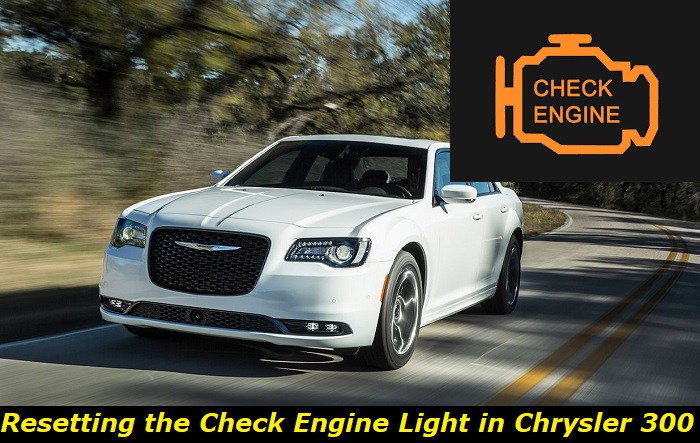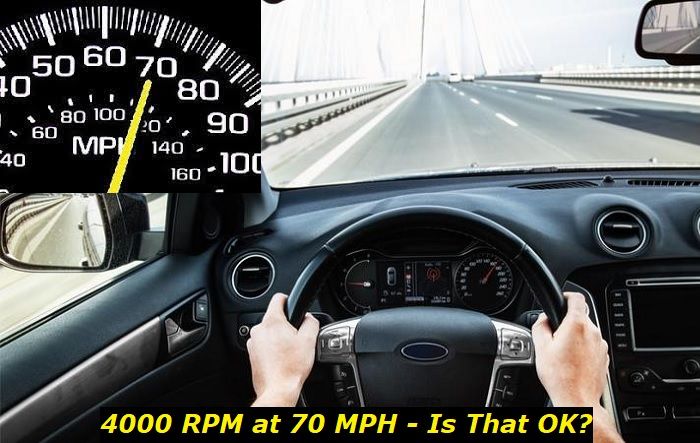The Chrysler 300 is known for its powerful performance, sleek styling, and comfort. It also features smart technology and advanced engineering. Like other car models, its check engine light comes on whenever there's an engine issue.
The check engine light can then go off after a reset and return on after a few drive cycles. This article will cover why the check engine light may come back on after a reset to help you get around the issue.

What's a Check Engine Light?
The check engine light is also called a malfunction indication lamp. It's part of an onboard diagnostic (OBD) system that gives a warning when something in the engine is amiss. Various sensors, such as the mass air flow, throttle position, position and speed, pressure, and knock sensors, collect data about the engine operations. They then take the data to the ECU (Electronic Control Unit). The ECU receives the data and responds accordingly.
Whenever the ECU receives information from the sensors that an engine part isn't performing correctly, it activates a brightly colored amber or yellow warning light on the dashboard. A check engine message usually accompanies the yellow/amber light. It can also include an engine symbol that has the word check.
You can also tell the issue's urgency by how the light appears. If the yellow light that comes on is static, the problem is less urgent. However, if the light flashes or turns red, the issue is dire and needs immediate attention.
When the ECU activates the amber warning light, it also stores some codes referred to as diagnostic trouble codes (DTC)in its memory. The codes make it easier for the car owner to identify what type of problem is troubling the engine. You can use a diagnostic tool to read the code.
An example is the "P0138" DTC code which denotes an issue with oxygen sensors-measure how rich or lean the air-fuel mixture in the engine is.
Why Shouldn't You Ignore Your Chrysler 300's Check Engine Light?
Ignoring the check engine light whenever it appears on the dashboard could lead to dire consequences down the road. The engine problem may continue slowly aggravating, leading to increased engine damage that warrants time-consuming and costly repairs. The engine may become irreparable, needing replacement that can blow a hole in your budget.
An example is if you ignore the check engine light that comes on due to a bad oxygen sensor. If you Ignore the light for long, it leads to the failure of the catalytic converter(reduces the vehicle's harmful emissions). It can also cause smoke to come out of the exhaust pipe. Like the engine, the catalytic converter is also costly to replace.
Reasons Why a Check Engine Light May Reappear on Your Chrysler 300
There are various reasons why the check engine light may reappear on the Chrysler 300. The check engine light may go out on its own, making you think you've resolved the issue, only to return after some time. Let's look at the reasons that can happen.
1) Failing to fix an Engine Issue
If an engine issue is left unresolved, it can make the check engine light reappear on your dashboard. This often happens when you make a wrong diagnosis, which results in fixing the wrong engine part. Resetting the ECU without fixing the underlying issue can also cause it.
During subsequent driving cycles, the car computer conducts diagnostic tests. That may bring back the same results of the issue present before the reset. Some problems that can offset the check engine light to illuminate are faulty spark plugs, a loose gas cap, bad sensors, fuel injectors, ignition coils, and a defective emissions system.
When you reset the ECU, it erases the fault code and the data from the freeze frame. The freeze frame data is a snapshot of real-time information that includes a parameter of different engine conditions. Once the ECU records the information, it leaves a diagnostic trouble code that helps determine which test failed.
This gives a clue as to which part is affected and is causing the underlying issue. Resetting the ECU can delete valuable information you may need to develop a clear diagnosis. The ECU can re-record the freeze frame data, but the snapshot may not be as reliable as the original one.
2) A Faulty Electronic Control Unit or an Electrical Problem
Another issue that may cause the check engine light to remain on and refuse to go off after a reset is an electrical problem or an ECU that's not functioning correctly. You can attribute this to an ECU activating false engine lights or warnings. A wrong jump-start that causes a short circuit in the ECU, a low voltage, an incorrect battery connection, and water corrosion are reasons why the ECU can become faulty.
False engine lights and faulty codes can negatively affect the car owner. This is because they can prompt the owner to replace the wrong part. This can be costly since there's usually no refund for a wrongly replaced part.
3) A Malfunctioned Alternator or Battery
A lousy alternator could also be why your check engine light is coming on. An alternator converts mechanical energy to electrical energy in the form of an alternating current. It then converts the alternating current to direct current to allow battery charging. The battery distributes the DC to the car's electrical system.
The conversion of AC to DC happens with the help of diodes in the alternator. When these diodes become faulty, the conversion can fail. This leads to the alternating current entering the car's electrical system. Because sensors also produce AC for the ECU to read, the circulating AC can lead to a wrong ECU interpretation. What follows is the ECU sending out false warnings.
One of the issues that can cause the ECU to be faulty is insufficient voltage from a bad battery. This is because apart from the battery supplying the vehicle with electricity, it also stabilizes the voltage that circulates the electrical system. If it's unable to do that, the check engine light may come on and off intermittently.
How Do You Fix the Issues Causing Your Check Engine Light to Come Back On?
Fixing the problem causing the check engine light to reilluminate depends on making the right diagnosis. Here's how you would fix the problem based on the reason causing it.
1) Dealing with an Engine Issue
For the check engine light to go off, you'll have to fix the engine issue that made it come on in the first place. This requires appropriately diagnosing parts like spark plugs, fuel injectors, catalytic convertors, oxygen and mass air flow sensors, and gas cap. Once you make the correct diagnosis, you'll have to fix the faulty part for the check engine light to turn off.
2) Dealing with a Faulty ECU
A faulty ECU needs a reset or reprogramming to tweak its software to stop giving false warnings or incorrect codes. It'll need replacement if the ECU misbehaves due to severe wear and tear or corrosion due to contact with water.
3) Dealing with a Defective Alternator and Battery
If the diodes are causing the check engine light to come back on, you'll have to replace them.
The alternator consists of six diodes distributed in two plates. Most auto repair shops recommend replacing the entire plate rather than just one or two individual diodes. This proves to be more cost-effective because you'll avoid paying for an alternator rebuild in the long run. You can revive a low-voltage battery by charging it or adding Epsom salt.
How to Reset a Check Engine Light of Your Chrysler 300
After fixing the underlying problem causing the check engine light to return, it may go out independently. However, the ECU requires a few drive cycles to read and interpret the change to normal engine parameters before deactivating the check engine light. In some instances, the check engine light may not go out on its own and requires the help of an OBD scanner or disconnection of the battery. Below is how to reset the check engine light using the two methods.
1) Use of an OBD Scanner
Here's how you can use the OBD scanner:
- The first step is to insert the OBD scanner into your car's OBD port which you'll likely find under the dashboard. A manual comes in handy if you can't spot the port's exact location.
- Turn on the ignition but don't crank up the engine.
- Use the diagnostic scanner to check for any new error codes.
- Use the scanner to clear the codes. This will reset the check engine light.
- Unplug the scanner and turn off the ignition.
2) Disconnect the Battery
The second method involves disconnecting the battery. This method is similar to how you'd reboot your computer. The downside to this method is that it can also reset other electronic components. Below is how you can disconnect the battery.
- Turn the ignition off and retrieve the key from the ignition lock.
- Locate the battery's negative terminal and loosen it using a wrench.
- Wait 45 seconds after disconnecting the negative terminal to drain the power.
- Put the negative terminal back onto the battery and tighten it using a wrench.
- Turn on the car and drive for about 15 miles for the ECU to adapt and retake the readings. This should reset the check engine light.
Bottom Line
There you go-why the check engine light may come back on in your Chrysler 300. It's vital to note that resetting the Check Engine Light without solving the underlying issue won't make the light disappear. It's also crucial to identify and address the case if, after being reset, the check engine light returns. Some problems may be hard to fix for the average DIYer, hence the need to seek the services of an expert mechanic.
About the authors
The CarAraC research team is composed of seasoned auto mechanics and automotive industry professionals, including individuals with advanced degrees and certifications in their field. Our team members boast prestigious credentials, reflecting their extensive knowledge and skills. These qualifications include: IMI: Institute of the Motor Industry, ASE-Certified Master Automobile Technicians; Coventry University, Graduate of MA in Automotive Journalism; Politecnico di Torino, Italy, MS Automotive Engineering; Ss. Cyril and Methodius University in Skopje, Mechanical University in Skopje; TOC Automotive College; DHA Suffa University, Department of Mechanical Engineering






Add comment